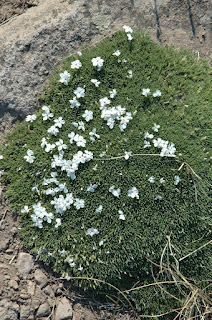Posted by Mark J. Platten, Teller County Extension Director for Colorado State University
When choosing a ground cover you should consider the length of the growing season, exposure and soil characteristics and cultural needs of the plant. Always amend your soil for better results. Be sure to choose plants that are hardy to USDA zones 2 to 4 for best results. Also consider the size of the area to be covered, steepness of slope and pedestrian traffic volume. Cultural factors to consider are soil texture and organic matter content, moisture and drainage, light exposure and micro-climate for the area in which you wish to plant.
To cover large areas look for plants that trail, creep, form mats, or spread by runners or rhizomes. Aggressive plants can spread into the landscape. For steep slopes, use species that produce dense, fibrous roots to help prevent soil erosion. Not many ground covers will tolerate repeated foot traffic except for grasses.
 |
| Courtesy of Joy Reis |
When purchasing your plants, select stock that originates from areas similar to yours since these tend to be hardier. Look for healthy plants that are not root bound or stressed in any way.
The best time to plant in our area is immediately after the last frost, which can be middle to late June in the mountain communities. Before planting, it is a good idea to acclimate your plants by gradually exposing them to longer periods outside over the course of a few days or weeks. This is known as “hardening” off. If the plants are grown outside at local nurseries this will not be necessary.
Our mountain soils generally benefit from amending with organic composts, sphagnum peat moss, composted horse or alpaca manures or a combination of these. Beware that if the horse manure is not properly composted, you may have weed seeds in the amendment. Another option to amending our mountain soils is to create and plant on a berm or raised bed. These options create drainage that is required by many garden plants.
 |
| Courtesy of Tami Sluder |
Most ground covers will require at least two years to establish. Snow cover acts as an excellent mulch in the winter months. It allows the root growth to occur during some periods of the winter. You can encourage snow to drift over the root zone by placing a snow fence a few feet upwind from the area.
Some ground covers to consider for mountain regions:
Prickly Thrift Dead Nettle
Wooly Yarrow Penstemon varieties
Bugleweed Creeping Phlox
Lady’s Mantle Soapwort
 |
| Courtesy of Joy Reis |
Rockcress Stonecrop sedum
Mountain Sandwort Hens and chicks
Sea Thrift Lambs Ear
Basket of Gold Wild Germander
Snow in summer Thyme
Iceplant Speedwell
Pinks Wild Strawberry
Sweet Woodruff Creeping Baby’s Breath
Most of the plants listed are easy to grow. One of my favorites is the Dragon’s Blood Sedum. It spreads very well and has nice color and texture. Some are deer and rabbit resistant. Others are good for borders or to line pathways. Get creative by mixing different textures, colors and bloom times.
Information for this article is from Fact Sheet 7.413 http://extension.colostate.edu/topic-areas/yard-garden/ground-covers-and-rock-garden-plants-for-mountain-communities-7-413/
